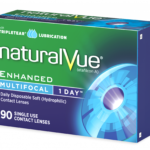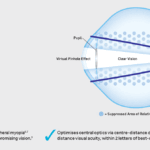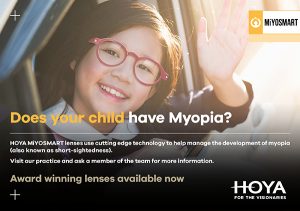Myopia Control
Myopia and Myopia Control.
What is myopia?
Myopia is an eye condition, also known as short-sightedness or near-sightedness, which causes people to have difficulty seeing distant objects clearly. Children will struggle to see the board at school, or the TV or perform less well in sports activities due to not being able to see distant objects as clearly as they should. Myopia is usually progressive and as a result changes occur in the physical structure of the eye, elongating it. These changes, especially in individuals with high levels of myopia, can significantly increase the risk of retinal detachment, myopic maculopathy, cataracts and glaucoma, in turn leading to vision loss and blindness.
Myopia usually begins in childhood at school age from age 6 onwards and can worsen until early adult years. It can also occur in adults (ages 20 to 40) with no prior history of problems in childhood, termed early adult-onset myopia. Babies can also be born with high levels of myopia (congenital myopia). The level of myopia is influenced by both genetic and environmental factors. It is more common in children with a parent that is also myopic, although sometimes there is no family history. One parent with myopia increases the risk of a child being myopic by 3X and both parents 7X. Children who spend little time outside are also more at risk, including those spending prolonged periods performing near vision tasks such as reading or gaming and poor lighting can also contribute to myopia progression.1
Myopia incidence and levels of myopia are increasing worldwide, especially in East Asia with reports of 90% of Chinese teenagers and young adults being myopic. It is becoming a worrying public health issue.
It is estimated that by 2050 half of the world’s population will be myopic. ²
Although there is no cure or quick fix for stopping myopia progression completely, it can now be slowed down several ways, resulting in a child being less myopic, with less potential for complications, associated with high myopia. The earlier treatment is started the better the results.
If you would like to experience how your child sees without their spectacles or contact lenses click the link below.
https://coopervision.co.uk/eye-health-and-vision/childhood-short-sightedness/myopia-simulator
Treatment options:
- MiSight 1 day contact lenses
- Specialist myopia control spectacles lenses, such as MiYOSMART
- Orthokeratology-Specialist rigid (hard) contact lenses worn overnight to reshape the front surface of the eye (cornea) and reduce the myopia. This is reversible once the lenses are stopped being worn.
- Soft multifocal monthly wear contact lenses- daily wear has shown to reduce the rate of progression but not as effective as MiSight
- Therapy with Atropine eyedrops, to affect the focussing. This treatment is currently although not available in optometric practice in the UK.
What is MiSight and how does it work?
MiSight is the first daily disposable contact lens that has been proven to slow the progression of myopia (short-sightedness) in children.
In a shortsighted eye, although the image is in focus in front of the retina , in the periphery the retina is less myopic. This is called relative hyperopic defocus and appears to be linked to an increase in myopia progression. Spectacles and traditional contact lenses correct the myopia at the centre of the retina making distance vision clear, but this in turn does not correct the relative hyperopia in the periphery and actually makes it worse which drives the myopia progression.
Dual focus contact lenses correct the central myopia but also move the peripheral focal point of the eye forward so it is in the front of the peripheral retina, not in front, reducing the hyperopic defocus, removing the stimulus for myopia progression.
MiSight has
- two treatment zones, creating myopic defocus in the periphery and
- two correction zones, correcting the myopia in all gaze positions, to ensure clear vision.
They are worn for a minimum of 10 hours a day, 6+ days per week, with a new pair being inserted each day. It is a commitment to wear lenses daily and is not available on the NHS. It is available on a planned monthly payment scheme, including all professional examination and fitting fees. Fitting is recommended as early as possible, when myopia first presents.
These lenses only cost a few more pounds than conventional soft contact lenses, which will not slow down the myopia progression. The fitting is charged at the same rate as for normal lenses.
Research and evidence
Studies have taken place at 4 sites across the world, involving myopic children aged 8 to 12 years old, over a 3 year period. The MiSight trials demonstrated a sustained reduction in myopia progression of 59% over this period of time when MiSight lenses were worn.³
MiSight 1 day is designed for children who have a myopic prescription from -0.25D to -6.00D. The lenses were found to be easy to insert, comfortable to wear, easy to remove and the children reported having clear vision at a variety of distances during everyday activities. 9 out of 10 children said they preferred wearing their MiSight 1 day lenses to wearing their spectacles.
Click the link below to find out more about the research.
NaturalVue Multifocal 1 Day contact lenses are clinically effective for myopia progression control and are an excellent option in slowing the progression of myopia in children. We have been using this lens with success within our Myopia Management Clinic since the lens launched in the UK in early 2019. Whilst initially being designed for use in over 45-year-olds suffering from presbyopia (the need for reading glasses or varifocals), NaturalVue has impressive myopia management credentials.
In September 2020, Visioneering Technologies Inc. (VTI), maker of the NaturalVue (etafilcon A) Multifocal 1 Day Contact Lenses presented exciting data at the Global Myopia Symposium. The 5-year study showed a consistent reduction in rates of myopia as well as a reduction in axial length with prolonged wear of NaturalVue contact lenses.
Unlike single vision or traditional multifocal lens designs, the Neurofocus Optics® design in NaturalVue® creates an extended depth of focus, enabling nearly 2 x the range of clear vision (up to 76cm) vs. Best corrected spectacle refraction, allows for better, nearly seamless vision at all distances and wearers experiences statistically significantly improved stereo acuity compared to leading lenses tested.
an extended depth of focus, enabling nearly 2 x the range of clear vision (up to 76cm) vs. Best corrected spectacle refraction, allows for better, nearly seamless vision at all distances and wearers experiences statistically significantly improved stereo acuity compared to leading lenses tested.
The science of Neurofocus NaturalVue® Multifocal 1 Day Contact Lenses are designed with a high amount of relative plus power in the periphery. This uninterrupted plus power progression induces peripheral blur in the brain.
MiYOSMART SPECTACLE LENSES
In 2012 Hoya worked with The Hong Kong Polytechnic University to develop a technology to slow down myopia progression using the defocus theory, the Defocus Incorporated Multiple Segments (D.I.M.S).
In a 2 year clinical wearer trial it proved to
- Slow down myopia progression by 59%
- Reduce axial elongation by 60%.4
MiYOSMART is non invasive and easy to fit like a regular spectacle lens.
The lens corrects the visual defect on its entire surface and has a ring shaped treatment area to slow down myopia progression. The alternation of the focus area and defocus area provides clear vision and manages myopia simultaneously.
It comes with an easy-to-wipe special anti-reflective, durable coating. With its Eye Shield, young patients get the added assurance of an impact resistant material and UV protection.
MYCON 
We are also suppliers of MyCon lenses from Rodenstock.
With MyCon lenses, light is diffused so that it strikes the periphery in front of the retina rather than behind it. This slows eye-length growth. The areas that control myopia progression in a MyCon lens are located laterally. This ensures that the visual acuity above and below is affected as little as possible.
Click the link below to find out more
https://www.rodenstock.com/uk/en/childrens-spectacles.html
To book an appointment or find out more, telephone 01606836582
- Global trends in myopia management attitudes and strategies in clinical practice. Wolffsohn JS, Calossi A, Cho P et al. Cont Lens Anterior Eye. 2016 Apr;39(2):106-16. doi: 10.1016/j.clae.2016.02.005. Epub 2016 Feb 16.
- Holden BA, Fricke TR, Wilson DA, Jong M, Naidoo KS, Sankaridurg P, Wong TY, Naduvilath TJ, Resnikoff S, Global Prevalence of Myopia and High Myopia and Temporal Trends from 2000 through 2050, Ophthalmology, May 2016 Volume 123, Issue 5, Pages 1036–1042. https://doi.org/10.1016/j.ophtha.2016.01.006.
- Chamberlain P, et al. A 3-year randomized clinical trial of MiSight® lenses for myopia control. Optom Vis Sci. 2019;96(8):556–567.
- 4Lam CSY, Tang WC, Lee RPK, Chun RKM, To CH. A randomized clinical trial for myopia control – use of myopic defocus spectacle lens. 8th International Congress of Behavioral Optometry (ICBO), 26-29 of April 2018. Sydney, Australia. 8Sankaridurg P1, Tilia D1, Morton M1, Weng R1, Jong M1, Zhu F2. Guidelines for Myopia Management.









